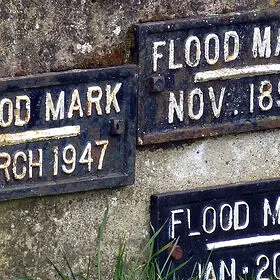Mold Today, Gone Tomorrow: 6 Budget-Friendly Tips for Mold Removal and Prevention
Summertime often spells disaster for old homes and historic properties. Higher humidity levels that warp walls and floors are also the perfect breeding conditions for everyone’s least favorite invasive species—mold. Mold is often difficult to remove and prevent, especially in older homes where maintaining historic integrity makes large renovation projects more complex.
Since the possibility of mold is often a part of life for owners of older homes, the National Trust is collaborating with Unico—maker of The Unico System small-duct central heating and cooling solution, and a fifteen-year corporate partner of the National Trust—to provide money-saving tips for mold prevention and removal.
Mold spores thrive in dark, damp spaces—think basements, bathrooms, and kitchens—and can spread easily throughout entire homes. To stop mold in its tracks, homeowners should try to remove the conditions that help it survive.

photo by: Stacey Swinehart/Flickr/CC BY NC-ND-2.0
Mold can ruin your home's structural integrity and affect your health.
1. Dehumidify everything.
Run dehumidifiers in the basement, where mold is most likely to grow, during the summer months—and be sure to clean out dehumidifier reservoirs with a bit of bleach in colder, drier months when they aren’t running.
2. Protect often-damp rooms.
Avoid using wall-to-wall or hard-to-remove carpets in bathrooms and kitchens where mold can build up, and clean any rugs or carpets you do own periodically. Whenever you pull out the vacuum cleaner, get one equipped with a HEPA (high efficiency particulate air) filter.
3. Air out your home.
Airing out your home can help reduce humidity. Whether you open up all the windows on a cool, dry day or run fans on particularly humid nights, proper ventilation is key to mold prevention.
4. Opt for something more comprehensive.
While the above mold-prevention techniques are great, Unico’s high-pressure heating and cooling system is a more comprehensive, cost-effective way to address high humidity levels that lead to mold infestations.

photo by: Janitors/Flickr/CC BY 2.0
Unico systems live in historic properties around the U.S., including outbuildings along the C&O Canal.
High-pressure heating and cooling systems like Unico can reduce up to 30% more humidity than a conventional air conditioning system. The system’s equipment fits into small spaces using tightly wound coils in its air handler, which are more densely packed than those of a standard unit. The result? Even when the Unico system’s thermostat is set to a higher temperature than that of the average cooling system, rooms and entire homes end up at a lower temperature (all while being more efficient and less expensive to install and maintain than standard systems).
What’s more, Unico’s system uses the force of constant air blowing at high levels of pressure to guard against internal build-up—a common problem for conventional heating and cooling systems—and the material used for the system’s duct work is impervious to mold and mildew.
5. Suck it up (literally).
While the previous tips are great for mold prevention, you may already be dealing with an infestation and need to turn to removal instead. You can attempt to clean up mild to moderate mold infestations on your own.
Preservation Tips & Tools: 10 Tips for Bringing Historic Properties Back From a Flood

Water damage can be one of the most devastating aspects of a natural disaster. Special care needs to be taken with historic buildings in order to limit the damage to irreplaceable materials and design elements.
Bleach, a commonly prescribed solution, does kill mold spores; unfortunately, it doesn’t make the dead spores any less of a threat to your health or home, and it also makes the remaining mold more difficult to see.
You can remove mold entirely with a vacuum equipped with HEPA filters. Loosen the spores with baking soda, which doesn’t damage surfaces like scraping them with a brush would. Then, suck up the mold with your vacuum, and sand any clean wood until it’s smooth. Use a biocide to remove any bacteria that might be left on infected surfaces.
Depending on the severity of the case, it may be necessary to enlist a professional.
6. Address your problem areas.
Once the mold has been removed, be sure to address any problem areas like a leaking roof or pipes. Patching any leaks you notice will stop a build-up of moisture that may have been the source of a mold infestation. You can use caulking to patch a leaky roof or an epoxy as a temporary fix for a leaky pipe, before calling the plumber to have it permanently repaired or replaced.
Armed with these tips and tricks, preventing that pesky summertime mold is a snap—leaving you to relax and enjoy a refreshing summer beverage from the comfort of your clean, cool historic home.



